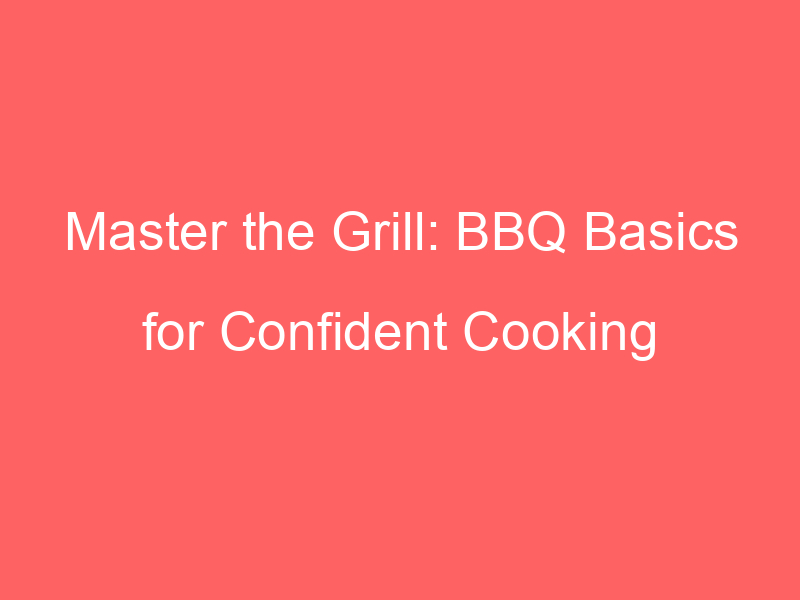Introduction to BBQ Cooking Basics
Barbecue, often abbreviated as BBQ, is more than just a method of cooking. It’s a social event, a source of entertainment, and an art form that requires skill and understanding. Whether you’re a beginner or a seasoned grill master, understanding the basics of BBQ cooking can elevate your culinary prowess to new heights. In this post, we will explore the importance of BBQ cooking skills and provide an overview of essential BBQ techniques.
- Understanding the importance of BBQ cooking skills
- Overview of essential BBQ techniques
- Direct Grilling: This is the most common technique, where food is cooked directly over the heat source. It’s perfect for small, thin pieces of meat that cook quickly.
- Indirect Grilling: In this method, food is cooked away from the heat source. It’s ideal for larger cuts of meat that require longer cooking times.
- Smoking: This technique involves cooking food at low temperatures in a controlled, smoky environment. It’s great for imparting a deep, smoky flavor to the food.
- Rotisserie Grilling: Here, food is skewered on a spit and rotated over the heat source. This method ensures even cooking and keeps the food juicy.
BBQ cooking skills are essential for a variety of reasons. Firstly, they allow you to create delicious meals that are sure to impress your friends and family. BBQ cooking also gives you the opportunity to experiment with different flavors and ingredients, providing a unique culinary experience. Additionally, these skills can be a great way to bond with loved ones, as BBQ cooking is often a communal activity. Lastly, mastering BBQ cooking can give you a sense of accomplishment and boost your confidence in the kitchen.
There are several BBQ techniques that every aspiring grill master should know. These include:
Understanding these BBQ cooking basics is the first step towards becoming a skilled grill master. In the following sections, we will delve deeper into each of these skills and techniques, providing you with the knowledge you need to confidently cook BBQ at home.
Essential BBQ Cooking Skills
Mastering the art of BBQ cooking requires a set of essential skills. One of the most important of these is understanding your grill. Let’s delve into this topic.
Understanding Your Grill
Grilling is more than just throwing food onto a heated surface. It’s about understanding the equipment you’re using and how to properly care for it. Here are two key areas to focus on:
- Types of grills and their uses
- Charcoal Grills: These grills use charcoal briquettes for heat. They are favored for the smoky flavor they give to food.
- Gas Grills: These grills use propane or natural gas. They are easy to use and heat up quickly, making them ideal for beginners.
- Electric Grills: These grills use electricity for heat. They are perfect for indoor grilling or places where gas and charcoal grills are not allowed.
- How to maintain and clean your grill
- Regular Cleaning: After each use, clean the grates to remove leftover food particles and prevent them from sticking to your next BBQ.
- Deep Cleaning: At least once a year, give your grill a deep clean. This involves removing and cleaning the grates and burners, and cleaning the inside of the grill.
- Proper Storage: When not in use, especially during winter, store your grill in a dry place and cover it to protect it from the elements.
There are several types of grills, each with its unique characteristics and uses. Here are the most common ones:
Maintaining and cleaning your grill is essential for its longevity and for the quality of your BBQ. Here are some tips:
Understanding your grill and how to care for it will set you on the path to becoming a BBQ master. Remember, a well-maintained grill is the key to delicious BBQ!
Mastering Heat Control
When it comes to BBQ cooking, understanding heat control is crucial. It’s like being the conductor of an orchestra, where the grill is your instrument, and the heat is your music. Let’s dive into the essentials of heat control.
- Understanding Direct and Indirect Heat
- How to Control the Temperature of Your Grill
- Know Your Grill: Every grill is different. Some heat up quickly, while others take time. Spend time getting to know your grill to understand how it works.
- Use a Thermometer: Don’t rely on guesswork. Use a grill thermometer to accurately measure the temperature.
- Control the Airflow: Remember, fire needs oxygen. By controlling the vents on your grill, you can control the amount of oxygen, and thus, the heat.
- Arrange the Coals Properly: For charcoal grills, how you arrange the coals can impact the heat. A thick layer of coals will provide high, direct heat. Spreading them out will create moderate heat, and pushing them to one side offers indirect heat.
Direct heat refers to grilling food directly over the heat source. This method is ideal for small, thin, and quick-cooking foods like burgers, steaks, and hot dogs. On the other hand, indirect heat means the food is not directly over the heat source. It’s similar to roasting or baking and is perfect for larger, tougher cuts of meat that need to cook slowly.
Controlling the temperature of your grill is a skill that requires practice. Here are some tips:
Mastering heat control can take your BBQ skills to the next level. Remember, practice makes perfect. So, don’t be afraid to experiment and learn from your experiences.
Basics of BBQ Techniques
Mastering the art of barbecuing requires understanding some basic techniques. In this section, we will focus on grilling, a popular and versatile BBQ method.
Grilling Techniques
Grilling is a high-heat method of cooking that sears the surface of the food, locking in juices and creating a delightful, crispy exterior. Let’s explore some grilling techniques for different types of food.
- How to grill different types of meat
- Preheat the Grill: Always preheat your grill 15-25 minutes before you start cooking to ensure it reaches the right temperature.
- Use a Thermometer: A meat thermometer is a must to ensure your meat is cooked to the desired level of doneness.
- Rest your Meat: After grilling, let your meat rest for a few minutes before serving. This allows the juices to redistribute throughout the meat, making it more tender and flavorful.
- Grilling vegetables for a balanced meal
- Choose the Right Vegetables: Not all vegetables are suitable for grilling. Some great options include bell peppers, zucchini, eggplant, and asparagus.
- Prep your Vegetables: Cut your vegetables into large, flat pieces that won’t fall through the grill grates. Coat them lightly in oil to prevent sticking.
- Grill over Medium Heat: Vegetables should be grilled over medium heat to avoid burning. Turn them occasionally for even cooking.
Grilling meat is an art that requires precision and patience. Here are some tips:
Grilled vegetables are a delicious and healthy addition to any BBQ meal. Here’s how to do it right:
Remember, practice makes perfect. The more you grill, the better you’ll get at judging when your food is done just the way you like it. Happy grilling!
Smoking Techniques
Mastering the art of smoking meat can elevate your BBQ cooking to a whole new level. This section will guide you through the essential techniques of smoking, including choosing the right wood and smoking meat for a tender and flavorful result.
- Choosing the Right Wood for Smoking
Choosing the right wood for smoking is crucial as it significantly impacts the flavor of your meat. Different types of wood impart different flavors. For instance, hickory and oak give a strong, smoky flavor, while apple and cherry woods provide a sweet, fruity taste. It’s important to match the wood to the type of meat you’re smoking. For example, hickory and oak are great for beef and pork, while apple and cherry woods are perfect for chicken and fish.
| Wood Type | Flavor Profile | Best For |
|---|---|---|
| Hickory | Strong, Smoky | Beef, Pork |
| Oak | Strong, Smoky | Beef, Pork |
| Apple | Sweet, Fruity | Chicken, Fish |
| Cherry | Sweet, Fruity | Chicken, Fish |
- How to Smoke Meat for a Tender and Flavorful Result
Smoking meat is a slow and low-temperature cooking process that infuses the meat with a smoky flavor while making it tender. Here’s a simple step-by-step guide:
- Preheat your smoker to the desired temperature, typically between 225°F and 250°F.
- While the smoker is heating up, season your meat with your chosen rub or marinade.
- Once the smoker is at the right temperature, place your meat on the grates, away from the heat source.
- Close the lid and let the meat smoke. The smoking time will depend on the type and size of the meat.
- Check the meat’s internal temperature with a meat thermometer to ensure it’s cooked to the desired level.
- Once done, let the meat rest for a few minutes before slicing to allow the juices to redistribute.
Remember, patience is key when smoking meat. It’s a slow process, but the result is worth the wait!
Confident BBQ Cooking
As you continue to hone your BBQ cooking skills, you’ll find that confidence is key. This section will guide you on how to develop your unique BBQ style, experiment with different flavors and techniques, and even create your own BBQ recipes.
Developing Your BBQ Style
Developing your own BBQ style is an exciting journey. It’s all about exploring different flavors, techniques, and creating your own recipes. It’s a process of trial and error, but the result is a BBQ style that is uniquely yours. Here’s how to get started:
- Experimenting with different flavors and techniques
- How to create your own BBQ recipes
Don’t be afraid to try new things. Experiment with different types of wood for smoking, various marinades, and unique spice blends. Each of these elements can drastically change the flavor of your BBQ. For example, using applewood can add a sweet, fruity flavor to your meat, while hickory provides a strong, smoky taste. Remember, the key to developing your own style is to keep experimenting until you find what works best for you.
Creating your own BBQ recipes is a fun and rewarding process. Start by taking a basic recipe and making small changes. Maybe you add a little extra brown sugar to your rub, or perhaps you try a different type of vinegar in your sauce. Keep track of what changes you make and how they affect the final product. Over time, you’ll start to develop recipes that are uniquely yours.
Developing your own BBQ style is a journey of discovery. It’s about finding what you love, experimenting with different flavors and techniques, and creating your own unique recipes. So, don’t be afraid to try new things and make mistakes. Remember, the most important thing is to have fun and enjoy the process.
BBQ Cooking for Beginners
Starting out with BBQ cooking can be a bit daunting, but with the right guidance, you can quickly gain confidence and start grilling like a pro. In this section, we will discuss common mistakes to avoid when starting out and provide tips for gaining confidence in your BBQ skills.
- Common mistakes to avoid when starting out
- Not preheating the grill: Just like an oven, a grill needs to be preheated before you start cooking. This ensures that your food cooks evenly.
- Overcrowding the grill: Give your food enough space to cook properly. Overcrowding can lead to uneven cooking and make it harder to manage your food.
- Not cleaning the grill: A dirty grill can affect the taste of your food and make it stick. Always clean your grill before and after each use.
- Tips for gaining confidence in your BBQ skills
- Practice makes perfect: The more you grill, the better you’ll get. Don’t be afraid to experiment with different foods and cooking techniques.
- Learn from others: Whether it’s a friend, family member, or a professional chef, there’s always something new to learn from others. Don’t be afraid to ask for advice or tips.
- Invest in good tools: High-quality grilling tools can make a big difference in your cooking. Invest in a good set of tongs, a meat thermometer, and a grill brush.
When you’re new to BBQ cooking, it’s easy to make a few mistakes. Here are some of the most common ones:
Building confidence in your BBQ skills takes time and practice, but here are a few tips to help you along the way:
Remember, BBQ cooking is as much about the journey as it is about the destination. So, don’t be too hard on yourself if things don’t go perfectly the first time. Keep practicing, keep learning, and most importantly, have fun!
Conclusion: BBQ Essentials for Every Cook
As we wrap up our discussion on BBQ cooking, we have covered a lot of ground. From the basics of BBQ cooking to the essential skills and techniques, we have given you a comprehensive guide. Let’s take a moment to recap and look at what we’ve learned.
- Recap of BBQ cooking basics:
- Encouragement for continued learning and experimentation:
We started with the basics of BBQ cooking, where we learned about the importance of choosing the right type of BBQ grill and the role of different types of fuel. We discussed the importance of temperature control and how to use indirect and direct heat methods. We also covered the significance of marinating and seasoning to enhance the flavor of your BBQ.
BBQ cooking is an art that requires practice and experimentation. Don’t be afraid to try new recipes, techniques, or flavors. Remember, every great BBQ cook started somewhere. With patience, practice, and a passion for BBQ, you can become a master at the grill. So, keep learning, keep experimenting, and most importantly, have fun with it!
In conclusion, BBQ cooking is more than just a way to prepare food; it’s a tradition, a passion, and a way to bring people together. Whether you’re a beginner or a seasoned cook, there’s always something new to learn in the world of BBQ. So, keep that fire burning, and happy grilling!






